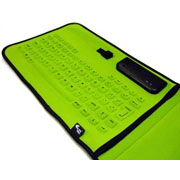
|
contents | hardware | |||||||
| Eleksen to Design ElekTex-Based Interfaces for Ultra-Mobile PCs  Eleksen Ltd. has announced it is working with Microsoft Corp. to deliver a range of ElekTex-based interfaces for new Ultra-Mobile PCs. The new peripherals designs include Eleksen's Bluetooth fabric keyboard and its new USB keyboard. Additionally, Eleksen will unveil a carrying case with an integrated keyboard and a range of designs that go beyond traditional functions to provide rich multimedia controls operated from the case cover itself. The designs include a variety of sensor layouts and control electronics that can easily be integrated into an Original Equipment Manufacturer's (OEMs) accessories products and are available immediately. Eleksen Ltd. has announced it is working with Microsoft Corp. to deliver a range of ElekTex-based interfaces for new Ultra-Mobile PCs. The new peripherals designs include Eleksen's Bluetooth fabric keyboard and its new USB keyboard. Additionally, Eleksen will unveil a carrying case with an integrated keyboard and a range of designs that go beyond traditional functions to provide rich multimedia controls operated from the case cover itself. The designs include a variety of sensor layouts and control electronics that can easily be integrated into an Original Equipment Manufacturer's (OEMs) accessories products and are available immediately.ElekTex gives OEMs an innovative interface technology, which supports their needs to develop dynamic and feature rich peripherals for this new mobile computing platform. The designs illustrate how textile interfaces can be integrated into some of the most common accessories and peripherals to extend the ease-of-use and enhance the mobility of these devices creating a new type of peripheral that complements the portability of Ultra-Mobile PCs. With ElekTex, interfaces can be developed into standalone accessories or can be built into protective cases and covers for Ultra-Mobile computing devices. Additionally, working with ElekTex, OEMs can integrate a myriad of interface interactions ranging from simple keyboard button functions to navigation scroll controls and even multimedia gesture controls into fabric-based products. OEMs can further build on these features and exploit ElekTex's core capability to be programmed and reconfigured by PC applications that can change the interface's design and function on-the-fly. This is a significant benefit when considering the portability requirements for peripherals designed for the Ultra-Mobile market - a single interface that doubles as a keyboard and media player controller is both compact and lightweight. write your comments about the article :: © 2006 Computing News :: home page |